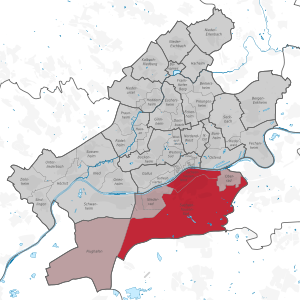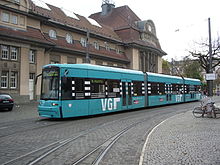Frankfurt-Sachsenhausen
|
Sachsenhausen-Nord Sachsenhausen-Süd 13/14. District of Frankfurt am Main |
|
|---|---|
| Coordinates | 50 ° 6 '23 " N , 8 ° 41' 15" E |
| surface | 34.770 km² |
| Residents | 61,968 (Dec. 31, 2019) |
| Population density | 1782 inhabitants / km² |
| Post Code | 60594, 60596, 60598, 60599 |
| prefix | 069 |
| Website | www.frankfurt.de |
| structure | |
| District | 5 - south |
| Townships |
|
| Transport links | |
| Highway |
|
| Federal road |
|
| Regional and S-Bahn | 50 55 64 65 S1 S2 S3 S4 S5 S6 S8 S9 |
| Tram and subway | U1 U2 U3 U8 12 15 16 17 18 19 20 21 |
| bus | 30 35 36 45 47 48 61 78 80 653 OF-50 n7 n62 n63 n71 |
| Source: Statistics currently 03/2020. Residents with main residence in Frankfurt am Main. Retrieved April 8, 2020 . | |
Sachsenhausen ( ) is a district of Frankfurt am Main . It is located on the left bank of the Main opposite the old town and has been part of Frankfurt since the Middle Ages. From an administrative point of view , Sachsenhausen is divided into Sachsenhausen-Nord and Sachsenhausen-Süd , but is generally regarded as a unit and has a population of 61,968. The border between north and south is formed by the Mörfelder Landstrasse, which partially runs parallel to the railway embankment and which continues in the east as Offenbacher Landstrasse. Sachsenhausen is densely built up throughout the north. The south, which is larger in terms of area, is mostly more loosely developed. A large part of the Frankfurt city forest also belongs to Sachsenhausen .
Sachsenhausen is known for its apple wine taverns , in particular Alt-Sachsenhausen is one of the main attractions for visitors to Frankfurt due to a cluster of restaurants. With the Binding brewery , the district is the traditional brewery location of Frankfurt; the neighboring Henninger brewery was shut down in 2001.
location
Sachsenhausen is located on the southern bank of the Main across from Frankfurt's old town and has been part of the city area legally and territorially since the Middle Ages, and it was included in the fortifications until they were abandoned in 1812. The district borders on Oberrad in the east , forms the city limits to the neighboring cities Offenbach am Main and Neu-Isenburg in the southeast and south and borders on the districts of Niederrad , Schwanheim and the airport in the west . While the northern part of Sachsenhausen has a relatively high population density, the Frankfurt city forest takes up most of the south.
In the Frankfurt dialect , Sachsenhausen is also called “Dribb de Bach” , ie “over there from the Bach”, on the other side of the Main. "Hibb de Bach" means "hüben vom Bach", ie on the northern side of the Main.
history

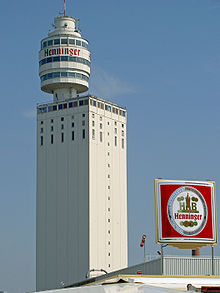

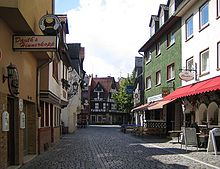
Emergence
In contrast to many other Frankfurt districts, Sachsenhausen, south of the Main, was never independent, but was part of Frankfurt as early as the Middle Ages. According to legend, Charlemagne, who was victorious in the Saxon Wars , after the blood court of Verden defeated Saxony in 782, settled on the Main opposite the royal palace of Frankfurt, which he founded . However, there is no historical evidence for this. There are also various other interpretations of the origin of the place name. The most probable of these is the assumption that the name is derived from Sassenhusen , a place where " Beisassen " lived - this was the name given to residents without full civil rights until 1866.
In the early 12th century, ministerials of the Palatinate Frankfurt settled on the south bank of the Main. The Große and Kleine Rittergasse in the old town center of Sachsenhausen remind of this today . The place is mentioned for the first time in 1193. In a certificate issued on March 29 in Speyer , Heinrich VI. the hospital, located in Sassenhusen prope Franchenfurt and built in 1190 by the ministerial Kuno von Munzenberg in honor of the glorious Mother of God , the royal allodial property on Frauenweg , the Sandhof . Kuno's son Ulrich I von Münzenberg had to leave the hospital and the associated church to Emperor Friedrich II in 1221 , as the estate was on Reichsboden. In November 1221, the emperor transferred it to the Teutonic Order for ever .
In addition to the lords of Hagen-Münzenberg, other families of imperial knights in Sachsenhausen can be found in the 13th century, including the lords of Sachsenhausen , von Praunheim , von Urberg , von Schweinsberg and von Stockheim . The only thing left of the knights of Sachsenhausen is their coat of arms (combined with that of those of Praunheim). This is used as a souvenir by the Sachsenhausen Well Society. The duties of the ministerial included the administration of the Frankfurt Palatinate and the imperial estates of the Dreieich Wildbanns lying on the southern bank . The names of the sexes can therefore also be found in the list of the Reichsschultheiss of Frankfurt .
The further settlement of Sachsenhausen seems to be related to the construction of the Old Bridge over the Main, which was first mentioned in a document in 1222, but its construction possibly as early as the end of the 12th century by Kuno von Munzenberg, who owned large estates on both sides of the Main bank, was initiated. The first wooden structure was replaced by a stone bridge in the middle of the 13th century.
In the course of the 13th century, Frankfurt grew from a small settlement around the Staufer Palatinate, the Saalhof , to a self-governing city that was able to acquire more and more privileges, e.g. B. through the release of pledged regalia , royal privileges such as taxes and customs duties. In 1220 the Frankfurter Landvogtei was abolished and an imperial school was established . From 1266, an existing from 43 members, the Council was officially recorded that year from 1311 two mayors elected. During this time the suburb of Sachsenhausen developed into part of the city of Frankfurt. For the first time it is explicitly mentioned as part of Frankfurt in the city peace of 1318 (a legal ordinance of the council).
Late Middle Ages and Modern Times
After initially only knight families had settled in Sachsenhausen, at the end of the 13th and 14th centuries fishermen, farm workers and artisans also settled on the southern bank of the Main. The Sachsenhausen Teutonic Order was the scene of important imperial political events. In the 13th century, at least three meetings of the General Chapter, the highest governing body of the order, took place here. The later Emperor Ludwig the Bavarian published the Sachsenhausen appellation on May 22, 1324 , in which he rejected the Pope's claim to the approval of a king's election. From then on, the approval of the majority of the electors was sufficient for the legitimate election of a king . An unknown priest of the Coming ( the Frankfurter ) wrote a mystical script in German , which was later published as Theologia deutsch by Martin Luther and was widely distributed. In 1338 the citizen of Sachsenhausen, Heile Dymar, donated a chapel from which the Dreikönigskirche was later built .
In July 1342, the Magdalen flood destroyed the Main Bridge and put all of Sachsenhausen seven to twelve shoes high under water, so that the entire population of Sachsenhausen had to take refuge on the hill of the Mühlberg.
In 1372 Frankfurt acquired part of the Reichsforst Dreieich , today's Frankfurt City Forest , from Emperor Charles IV. At the end of the 14th century Sachsenhausen was included in the Frankfurt city fortifications . At that time Sachsenhausen had about 2700 inhabitants. Among the fourteen advisable guilds in Sachsenhausen were in particular the tanners, fishermen, boatmen and gardeners, as well as foresters, bird catchers, saws, basket makers and broom makers.
In 1414 a wooden observation tower on the Mühlberg was replaced by a new, stone observation tower, which was destroyed in 1416 by the Archbishop of Trier, Werner von Falkenstein (1388–1418). In 1470/71, on the higher Sachsenhausen mountain, at the highest point of the road leading to the south, the new Sachsenhausen observation tower was built as part of the Frankfurter Landwehr , one of the four Frankfurt waiting towers still preserved today . Based on the model of the already existing Gallus and / or Bockenheimer Warte , a small castle with houses, weapons storage, watchtower and fountain was built.
The city gates and the gates of the bridge towers remained locked at night so that no one could get in or out. Traffic to and from Frankfurt was also impossible. Since there was no pastor in Sachsenhausen, but the parish rights for ecclesiastical acts in the whole city belonged exclusively to the pleban of the Bartholomäusstift , so no pastoral support for the Sachsenhausen was possible at night. This led to great dissatisfaction among the citizens of Sachsenhausen. Only in 1452 did the city, through the mediation of Cardinal Nikolaus von Kues, raise the Epiphany Church to the branch church of St. Bartholomäus. The Reformation quickly found many followers in Sachsenhausen. In 1525, the Dreikönigskirche became the first church in Frankfurt to have exclusively Reformed preachers. In 1531 the church received a permanent evangelical preacher, Petrus Pfeiffer, who had previously been the last guardian of the Frankfurt Barefoot Monastery .
In the course of the city fortifications, the Kuhhirtenturm , also known as the elephant , was built in 1490 as a further defense tower on the banks of the Main . The city fortifications had to pass their greatest test in the late summer of 1552 during the three-week siege by troops of the Elector of Saxony.
17th and 18th centuries
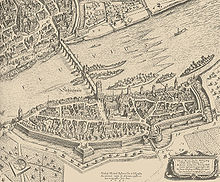
After the Fettmilch uprising of 1614, the council issued new district regulations to divide the urban area within the old city walls into 14 quarters . Similar to the Contraden in Siena or the Sestieri in Venice today , the quarters formed social communities within urban society. Each quarter consisted of 170 to 270 houses, which were numbered within the quarters. A modern numbering system according to streets was only introduced in Prussian times. 12 quarters (A to M) were north of the Main, quarters N and O in Sachsenhausen. The border between the eastern quarter N - also called Oberhausen - and the western Unterhausen (quarter O ) was the Brückengasse .
In 1769 the Sachsenhausen bridge tower fell as an obstacle to traffic.
19th century

At the beginning of the 19th century, the fortifications in Frankfurt were razed. In 1809 the Affentor disappeared and by 1812 also the rest of the Sachsenhausen fortifications except for the Kuhhirtenturm and the ruins of the Ulrichstein. The population structure gradually changed: traditionally a village of artisans - in 1781 there were 336 winemakers and gardeners, 125 fishermen, 30 brewers, 22 bakers and 20 tanners - wealthy citizens were increasingly drawn to it in the late 18th and especially in the 19th century Sachsenhausen.
The settlement area expanded first to the south and later also in an east-west direction, and the population, which had stagnated at a low level until then, rose rapidly, especially in the 19th century: in 1761 there were around 4,000 and in 1811 5,000 people in Sachsenhausen resident. By the end of the Free City of Frankfurt in 1866, their number rose to around 8,000, which was just under 10% of the total population. Especially after the Franco-German War in 1870/71, Sachsenhausen experienced a population explosion. In 1890 around 24,000 people lived here, in 1900 over 36,000 and in 1912 around 50,000.
The first summer houses and villas were built along the banks of the Main, and industrial and commercial enterprises settled on the edge of the residential areas in southern Sachsenhausen. In 1846 the Main-Neckar-Bahn opened its operations, which initially ended at the Mainspitze station on the Sachsenhausen Mainufer before the first Main-Neckar railway bridge was built in 1848 . As early as 1847, the Frankfurt-Offenbacher local railway, the second railway line in Sachsenhausen, went into operation, the local train station near the Affentor served passenger traffic until 1955. In 1873 the Frankfurt-Bebraer Eisenbahn started operations, for which a new station, the Bebraer Bahnhof, today Südbahnhof , was built, which received its reception building in 1924, which has been preserved to this day. With the Untermainbrücke and the Obermainbrücke , two more traffic routes across the Main were built in 1874 and 1879.
As a replacement for the built c.1340 hospital chapel to the Three Kings , who had since 1452 also the parish church, was in 1875 and 1881 was led by cathedral architect Franz Josef von Denzinger the Epiphany Church in neo-Gothic style built, the 80-meter tower, the Sachsenhausen Main river still dominates today. The 15 glass paintings of the nave and the tower window were created by Charles Crodel in 1956/57.
Numerous bourgeois villas were built along the shore, on Schaumainkai , and the Städelsche Kunstinstitut was also built here from 1874 to 1878 .
From 1884, one of the world's first electric trams operated by the Frankfurt-Offenbacher Trambahn-Gesellschaft, founded specifically for the construction of the line, ran from the Alte Brücke through Sachsenhausen. The route initially led to the neighboring Oberrad and was extended shortly thereafter to Offenbach am Main . Another tram line was opened in 1889: the Frankfurt Waldbahn connected Sachsenhausen with Neu-Isenburg , Niederrad and Schwanheim, which was still very remote at the time . In 1899, the Sachsenhausen depot was built as the first own depot for the Frankfurt tram .
20th century

In the 1920s, a sports facility was built in the city forest with the Frankfurt Waldstadion , which was inaugurated in 1925, a cycling track (demolished again in 2002), a swimming stadium and a sports hall. The stadium and grounds were also used by the NS regime ( National Socialists ) in the 1930s for political marches and meetings. In the 1920s, the home settlement was built and Frankfurt was expanded to the south.
During the Second World War , from 1943 onwards , about 40% of the total was destroyed by Allied air raids . As a result, the population fell temporarily from just under 53,000 before the war to 34,700, but grew again quickly in the 1950s. Two larger settlement complexes stand out from the usual structural extensions of the district: the high-rise housing estate on Sachsenhäuser Berg ("Sonnenring" and "Sonnenhügel") that was built in the 1970s and the Deutschherrnviertel on the south-eastern bank of the Main on the former Frankfurt slaughterhouse site in the 1990s . Despite its location close to the city center, Sachsenhausen is not yet considered overpriced; in terms of rental prices, it only ranks fourth in the north Main district of Westend, Nordend and Ostend. However, a trend towards a shortage of rental apartments can be observed here too, many of the mostly Wilhelminian-style properties are being renovated and marketed as owner-occupied apartments.
In the post-war period, Sachsenhausen became known both nationally and internationally thanks to its accumulation of cider bars, beer bars and night bars in the Alt-Sachsenhausen quarter and became a tourist attraction thanks to the US armed forces based in the Rhine-Main area.
Institutions
The campus of the Philosophical-Theological University of Sankt Georgen has been located on the eastern outskirts of Sachsenhausen since 1950 . The voluntary fire brigade of the Oberrad district is located diagonally opposite in the direction of the center of the district.
The Sachsenhausen hospital and the eastern part of the university clinics are located in the northern part of the city . In addition, the fire brigade's area control station 4 , the Sachsenhausen volunteer fire brigade and the 8th and 9th police stations are located there.
Culture and sights

- 13 museums are located along the Main on the so-called Museumsufer , including the Städel , one of the most important and well-known art museums in Germany.
- One of the most striking buildings is the Dreikönigskirche , built in 1881 in neo-Gothic style .
- The Eiserne Steg : A pedestrian bridge that connects Frankfurt's old town with the Sachsenhausen district. The bridge was immortalized in a painting by Max Beckmann .
- The Sachsenhausen guard tower is a late Gothic defense tower that was left over from the Frankfurt Landwehr and is one of the four remaining Frankfurt guard towers.
- The cowherd's tower with the cowherd's gate is another part of the fortifications that have been preserved.
- The Affentorhäuser are two classicist guard buildings that were built from 1810 to 1811.
- First erected in 1867 and in its current form in 1931, the Goetheturm is one of the tallest wooden buildings in Germany at 43 meters. It stands on the Sachsenhausen edge of the Frankfurt city forest on the high bank of the Main.
- The Klappergasse is the center of the Sachsenhausen cider district. The Frau Rauscher fountain , erected in 1961, is dedicated to the most famous Sachsenhausen original , Fraa Rauscher . Those who pass by here should be careful, as they splash water on the street at irregular intervals. The Steinern House is diagonally across from the Frau-Rauscher-Brunnen . It is a late Gothic building from around 1450 and one of the oldest stone houses in Sachsenhausen. Stone houses were unusual in Frankfurt in the Middle Ages; half-timbered construction dominated here until the end of the 18th century .
- The house at Schellgasse 8 is the oldest preserved half-timbered building in Frankfurt (built in 1291/1292).
- The 1912-13 in Art Nouveau Built Luke Church , popularly known because of their (former) picturing Frankfurt Bilderkersch called.
- The Henninger Tower , built from 1959 to 1961 and demolished in 2013, was a former brewery silo and as such one of the highest in the world. The tower was one of the landmarks of Sachsenhausen and Frankfurt. He became internationally known for the cycle race called Around the Henninger Tower until 2008 . From 2014 to 2017, the Neue Henninger-Turm was built , the second-highest residential tower in Frankfurt at 140 meters, the appearance of which is based on the previous building.
- The home settlement is interesting for architects . The 'New Frankfurt' settlement from the 1930s is a listed building and therefore - unlike other May settlements - is still close to its original state.
- The oldest mosque in Frankfurt is the Nuur Mosque, opened in 1959 by the Islamic denomination Ahmadiyya Muslim Jamaat , on Babenhäuser Landstrasse.
- Main Plaza , residential building since 2001, 88 m high.
- The parish church of St. Wendel, completed in 1957, and the Easter church , built in 1959
- The Catholic Church of St. Bonifatius on Holbeinstrasse was built in 1926/27 in an expressionist style.
- In the 1950s, a residential area developed on Sachsenhausen Mountain, for which a Protestant parish hall was built in 1958 on Sachsenhausen Landwehrweg. An architectural competition was held for the construction of a new church. The mountain church arose from this .
- There are also a number of stumbling blocks that are supposed to remind of the lives of Jews and other victims of Nazi persecution in Sachsenhausen.
Sachsenhausen originals
Sachsenhausen is known for its bizarre characters that it has produced over the centuries. The best-known of them lived in the 19th century: A wide variety of memories were dedicated to Fraa Rauscher from de Klappergass : a memorial that spits on passers-by with water at unexpected moments, a well-known street hit (composed in 1929 by the Frankfurt graphic artist Kurt Eugen Strouhs ) and a variety of apple wine of the Possmann press from Frankfurt-Rödelheim .
A contemporary Sachsenhausen original is the naked Jörg , a nudist who has occasionally been seen in Sachsenhausen for many years. He never wears clothes - except for a pair of sandals in winter - just his Walkman. It is based in the residential area on Sachsenhäuser Berg. Its identity and its motivations are the subject of numerous legends ; According to his own statements, he suffers from a clothing allergy. T-shirts with his picture already exist and he was the subject of the hand-made speakers at Carnival .
Regular events
- The Museumsuferfest , originally conceived as a promotional event for the Frankfurt museums, has meanwhile transformed into an event with the character of a folk festival and with three million visitors is the largest event in the Rhine-Main area.
- The Sachsenhausen fountain festival of the fountain and notch society Sachsenhausen e. V. was mentioned in a document as early as 1490, making it one of the city's oldest festivals.
- The Goethe Tower Festival of the Vereinring Sachsenhausen e. V. has been taking place on the first Saturday in May at the foot of the Goethe Tower since 1982 .
- Every year in September, the Sachsenhausen volunteer fire brigade's club festival takes place at their location.
- One of Germany's largest and most traditional weekly flea markets takes place on the Sachsenhausen Mainufer every 2nd Saturday morning from 9 a.m. to 2 p.m. On the other Saturdays the flea market was moved to the Osthafen.
Economy and Infrastructure
traffic

The route of the Frankfurt-Offenbacher Trambahn-Gesellschaft (FOTG) opened on February 18, 1884, at the end of an Offenbach consortium consisting of the Kommerzienrat Weintraut, the banker Weymann and the Bankhaus Merzbach, starting from the Alte Brücke in Sachsenhausen, was the first commercially operated public electric tram in Germany . The route initially led to Buchrainstrasse in Oberrad and from April 10th to Mathildenplatz in Offenbach . At that time, the FOTG still used a gauge of 1000 mm ( meter gauge ).
Like all Frankfurt districts, Sachsenhausen is connected to local public transport . The lines U1, U2, U3 and U8 of the metro connect Sachsenhausen to the north of Frankfurt and the city center . The tram line 12 runs from the Rheinlandstraße in Schwanheim about Niederrad and Sachsenhausen to Fechenheim ; Line 15 (Niederrad, Haardtwaldplatz - Offenbach ) has its final stop at the Südbahnhof in Sachsenhausen outside of working hours and during holidays ; Line 16 runs from Ginnheim to Offenbach; Line 17 has been running from Rebstockbad via the main train station to Neu-Isenburg since December 13, 2014 ; Line 18 from Louisa train station via Konstablerwache and Friedberger Landstraße to Gravensteiner Platz in Preungesheim ; Line 19 runs from Schwanheim to Sachsenhausen during school time for students at Sachsenhausen schools and line 21 runs from the Waldstadion via Niederrad and Sachsenhausen to Nied during their working life . Bus routes 30 ( Bad Vilbel - Hainer Weg), 35 (Stresemannallee / Mörfelder Landstraße - Sachsenhausen Lerchesberg), 36 ( Westbahnhof - Hainer Weg), 45 (Sachsenhausen Deutschherrnviertel - Südbahnhof), 46 (Römerhof - Hauptbahnhof - Mühlberg - Gerbermühle / Offenbach Kaiserlei ), 47 (Am Sandberg - Südbahnhof), 61 ( Airport - Südbahnhof), 78 (Schwanheim Rheinlandstraße - Südbahnhof), as well as bus line 80 (Stadion Osttribüne - Südbahnhof), OF-50 (Neu-Isenburg ) for major events in the Commerzbank-Arena Gravenbruch - Südbahnhof) and 653 ( Götzenhain - Südbahnhof) also run through Sachsenhausen. In addition, the S-Bahn lines S3 ( Bad Soden - Darmstadt ), S4 ( Kronberg - Langen ), S5 ( Friedrichsdorf - Ffm-Süd) and S6 ( Friedberg - Südbahnhof) run through Sachsenhausen, Mühlberg in the east is served by the S -Bahn lines S1, S2, S8 and S9 served.
education
In Sachsenhausen there are five primary schools (Mühlbergschule, Textorschule, Willemerschule, Riedhofschule and Martin-Buber-Schule), three grammar schools ( Schillerschule , Carl-Schurz-Schule and Freiherr-vom-Stein-Schule ), two secondary schools (Deutschherrenschule and Holbeinschule) and the Hauptschule Schwanthalerschule. There is also a private school there, the Freie Schule Frankfurt. In addition, the Frankfurt Abendhaupt and Abendrealschule is located in Sachsenhausen.
Streets in Sachsenhausen
Sons and daughters of Sachsenhausen
- Johann Richard von Franckenstein (1608–1675), provost in the diocese of Würzburg
- Johann Christoph Freyeisen (1803–1849), publicist, music writer and librettist
- Arthur von Bolfras (1838–1922), head of the military chancellery of Emperor Franz Joseph and colonel general of the Austro-Hungarian army
- Paul von Joukowsky (1845–1912), Russian-German set designer and writer
- Jakob Riesser (1853–1932), politician (DVP), member of the Reichstag
- Moritz Levi (1857–1942), American Romanist
- Hans Hubert Dietzsch (1880–1926), sculptor, painter and actor
- Alfons Kassel (1902–1975), banker
- Wilhelm Windecker (1908–1979), biologist and zoo director
- Marianne Beuchert (1924–2007), florist and gardener
- Martin Fochler (* 1946), chemical laboratory assistant and functionary of the Left Party
- Klaus Möller (1952–2013), author, presenter, producer and director
- Harald Dörig (* 1953), lawyer
- Thomas Reußenzehn (* 1955), electrical engineer and producer of tube amplifiers
Worth knowing
Frank Demant has the life artist and former tram driver Simon Schweitzer investigated in a series of local crime stories in Frankfurt-Sachsenhausen. So far (2018) twelve novels have been published in this series (see: here ).
literature
- Friedrich Bothe : History of the city of Frankfurt am Main . Verlag Wolfgang Weidlich, Frankfurt am Main 1977, ISBN 3-8035-8920-7
- Alexander Dietz , old Sachsenhausen. Edited from the estate by Fried Lübbecke . Brönner-Verlag, Frankfurt am Main 1935
- Frankfurt Historical Commission (ed.): Frankfurt am Main - The history of the city in nine contributions. (= Publications of the Frankfurt Historical Commission . Volume XVII ). Jan Thorbecke, Sigmaringen 1991, ISBN 3-7995-4158-6 .
- Walter Gerteis: The unknown Frankfurt. 3 volumes. Verlag Frankfurter Bücher, Frankfurt am Main 1960–1963
- Helmut Nordmeyer: Tour through the old Frankfurt-Sachsenhausen , Wartberg-Verlag, Gudensberg-Gleichen 2003, ISBN 3-8313-1088-2
- Sachsenhausen views , exhibition catalog of the Institute for Urban History , Frankfurt am Main 1998 (PDF; 1.3 MB)
- Vinz de Rouet: I love Sachsenhausen! 33 reasons to love Sachsenhausen. Berlin 2010. ISBN 978-3-86931-738-0
- VHS authors' group: Paths through Sachsenhausen , Dreieich 1987, Verlag Heinz P. Conté, ISBN 3-920185-25-0
- Antje Jens (Ed.) Sachsenhausen Authors ' Community A Closer Look, Rediscover Sachsenhausen , Frankfurt am Main 2005, Sociätsverlag, ISBN 3-7973-0929-5
- Jens-Holger Jensen, Günter Appel, Georg Becker, Sachsenhausen a closer look at DIE TEXTORSTRAßE History & Stories, Frankfurt am Main, 2012, Editions Henrich, ISBN 978-3-921606-91-9
- Paul Quilling; All sorts of sagas and humor from Sachsenhausen . Printed and published by Gebr. Fey Frankfurt am Main 1883
Web links
- My district - my home on YouTube
- Sachsenhausen. altfrankfurt.com
- Literature about Frankfurt-Sachsenhausen in the Hessian Bibliography
- The district portal of Frankfurt-Sachsenhausen
- Sachsenhausen club ring
- 360 ° panoramic views of Sachsenhausen
- YouTube: Sachsenhausen - The city within the city (Video, 5:26 min.)
Individual evidence
- ↑ City planning office Frankfurt am Main, overview map Sachsenhausen-Nord
- ↑ Eine Erbarn Raths Der Statt Franckfurt am Mayn Quartir -ordnung , Frankfurt am Main, October 25, 1614. A detailed account of the history of the district can be found in: Wolfgang Klötzer, Vom Stadtquartier zum district , printed in: No dearer city than Frankfurt. Studies on Frankfurt History Volume 45 , Waldemar Kramer Verlag, Frankfurt am Main 2000, ISBN 3-7829-0509-1
- ↑ Initiative group of the "Frankfurter Interkulturellen Wochen" (Ed.): 1989–2009 Office for Multicultural Affairs // City of Frankfurt am Main . 2009, p. 128 ( online , PDF [accessed on February 26, 2020] Program of the Intercultural Weeks in Frankfurt 2016).
- ^ Art in public space Frankfurt , Fraa-Rauscher-Brunnen
- ↑ frankfurt-interaktiv.de: Frankfurter Flhmarkt ( Memento of the original from March 2, 2009 in the Internet Archive ) Info: The archive link was inserted automatically and has not yet been checked. Please check the original and archive link according to the instructions and then remove this notice.
- ↑ Flea market dates ( Memento of the original from August 26, 2009 in the Internet Archive ) Info: The archive link was inserted automatically and has not yet been checked. Please check the original and archive link according to the instructions and then remove this notice.
